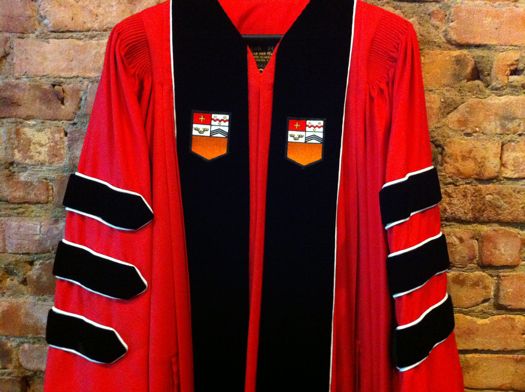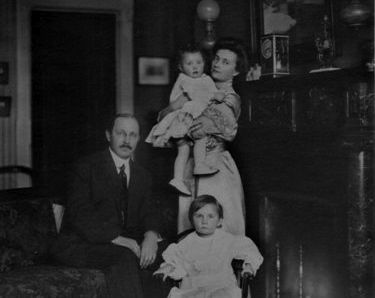Albany, academic fashion trendsetter

Bright.
Albany didn't really have a full-fledged university until the 1960s -- it missed its chance when the Albany Rural Cemetery board miffed Leland Stanford.
But by that time, the city had already left a lasting mark on American academia: the standardized cap and gown.
Sure, the gown itself is thought to go back to medieval times, when most scholars were part of a religious order. And the original gown became a prescribed form of dress at Oxford and Cambridge. But the gown as we know it today was created by an Albany man.
Academic regalia in the United States began in colonial times and lasted almost until the Civil War as ordinary daily dress. But the tradition by which certain colors represented certain fields of study simply didn't exist.
 Enter Gardner Cotrell Leonard -- a student at Williams College (class of '87 -- 1887) in nearby Williamstown, Massachusetts -- whose family tailored and sold dry goods at 472-478 Broadway in Albany. His work designing his class' graduation gowns spawned in him a considerable interest in creating a system of caps and gowns that would, at a glance, show the academic interest and degree status of the wearer.
Enter Gardner Cotrell Leonard -- a student at Williams College (class of '87 -- 1887) in nearby Williamstown, Massachusetts -- whose family tailored and sold dry goods at 472-478 Broadway in Albany. His work designing his class' graduation gowns spawned in him a considerable interest in creating a system of caps and gowns that would, at a glance, show the academic interest and degree status of the wearer.
In an 1893 article for University Magazine, Leonard wrote:
[The cap and gown] serves to remind those who don it of the continuity and dignity of learning, and recalls the honored roll of English-speaking University men. On its democratic side, it subdues the differences in dress arising from the differences in taste, fashion, manners and wealth, and clothes all with the outward grace of equal fellowship which has ever been claimed as an inner fact in the republic of learning.
Leonard assured his readers that "the technical difficulties of all these gowns have been mastered by our American gown-makers" and he asserted that it would be desirable to adopt the gown throughout the year. He also impressed upon his readers the fact that "gown-makers, on account of manufacturing largely and obtaining their fabrics at first hands, are able to provide outfits at prices often less than the cost of the material if purchased through the local channels of trade." Gown-makers, it must be said, like Cotrell and Leonard of Albany -- then the only cap-and-gown company in the country.
Leonard's drive led to the establishment of an Intercollegiate Commission at which representatives of the leading institutions of the day met and, in 1895, adopted a code of academic regalia that prescribed the cut, style, and materials for gowns, as well as the colors of trim that represented different fields of learning. At the time, that meant that arts and letters wore white trim, theology wore scarlet, law purple, philosophy blue, science gold, fine arts brown, music pink, and medicine wore green.

Having established this new standard and reaffirmed the place of the cap and gown in American academics, the family business enjoyed a significant boom. Cotrell and Leonard still exists as a part of Oak Hall Cap & Gown, a Virginia manufacturer.
Gardner Cotrell Leonard died in 1921 and is buried, like all good native sons, in Albany Rural Cemetery.
Carl Johnson writes about history and other fun stuff at Hoxsie! and My Non-Urban Life.
More Carl on AOA:
+ The longstanding New York tradition of "investments in legislators"
+ A future in plastics and billiard balls
+ The Moses fountain in Washington Park
+ The highway that was almost buried under Washington Park
+ Why Stanford isn't in Albany
Say Something!
We'd really like you to take part in the conversation here at All Over Albany. But we do have a few rules here. Don't worry, they're easy. The first: be kind. The second: treat everyone else with the same respect you'd like to see in return. Cool? Great, post away. Comments are moderated so it might take a little while for your comment to show up. Thanks for being patient.
Comments
I graduated from UAlbany in 2007. I believe mine was the first class to wear the new purple regalia. We're talking purple, purple. When I walk in Commencement ceremonies now, I always get stopped by at least 2 parents as I'm walking in to tell me how purple I am.
By the way, it was $800 and made by Oak Hall. At that point, though, I just wanted to graduate and I was willing to write checks to anyone who wanted one.
And even though it's purple and was insanely expensive, it means I have my PhD. That's a good thing.
... said Angela on Aug 31, 2011 at 6:51 AM | link